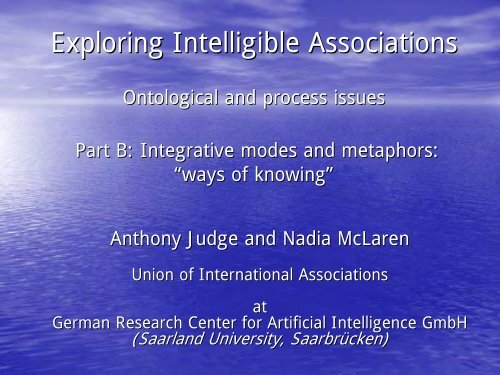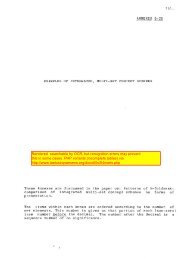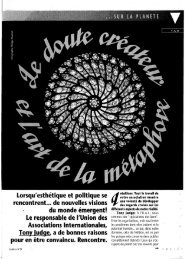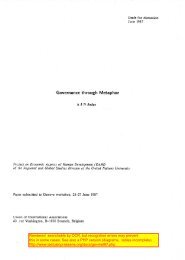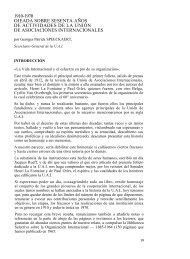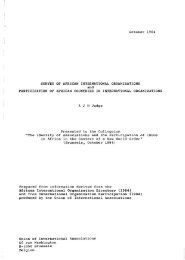Integrative modes and metaphors - Laetus in Praesens
Integrative modes and metaphors - Laetus in Praesens
Integrative modes and metaphors - Laetus in Praesens
You also want an ePaper? Increase the reach of your titles
YUMPU automatically turns print PDFs into web optimized ePapers that Google loves.
Explor<strong>in</strong>g Intelligible Associations<br />
Ontological <strong>and</strong> process issues<br />
Part B: <strong>Integrative</strong> <strong>modes</strong> <strong>and</strong> <strong>metaphors</strong>:<br />
“ways of know<strong>in</strong>g”<br />
Anthony Judge <strong>and</strong> Nadia McLaren<br />
Union of International Associations<br />
at<br />
German Research Center for Artificial Intelligence GmbH<br />
(Saarl<strong>and</strong> University, Saarbrücken<br />
cken)
2. Associations <strong>and</strong> complexity<br />
– cognitive <strong>and</strong> otherwise<br />
2
Evolv<strong>in</strong>g pattern of associations<br />
<strong>in</strong> a learn<strong>in</strong>g society<br />
• Associations of ideas, concepts, , theories<br />
• Associations of different technologies<br />
• Associations across cultures<br />
• Associations across faiths <strong>and</strong> beliefs<br />
• Associations of values (for quality of life)<br />
• Aesthetic associations<br />
• Associations of people <strong>and</strong> other bodies<br />
3
Strategic opportunities for association<br />
• New associations of ideas, concepts, , theories<br />
• New associations of different technologies<br />
• New associations across cultures<br />
• New associations across faiths <strong>and</strong> beliefs<br />
• New aesthetic associations<br />
• New <strong>metaphors</strong><br />
• New associations of people <strong>and</strong> other bodies<br />
4
Implement<strong>in</strong>g associative strategies<br />
• Explor<strong>in</strong>g new patterns of concepts, theories<br />
• Explor<strong>in</strong>g new <strong>in</strong>ter-modal technologies<br />
• Explor<strong>in</strong>g cross-cultural cultural fertilization<br />
• Explor<strong>in</strong>g dialogue across faiths <strong>and</strong> beliefs<br />
• Explor<strong>in</strong>g new aesthetic associations<br />
• Explor<strong>in</strong>g new <strong>metaphors</strong><br />
• Explor<strong>in</strong>g new associations of people,<br />
groups,etc<br />
5
3. Crisis of mean<strong>in</strong>g<br />
-- faith-based vs evidence-based<br />
reality<br />
6
Contemporary crisis of mean<strong>in</strong>g<br />
• Conceptual <strong>in</strong>coherence <strong>in</strong> strategy<br />
– global<br />
– local<br />
• Loss of sense of direction<br />
• Loss of faith <strong>in</strong> systems <strong>and</strong> beliefs<br />
• Fragmentation of <strong>in</strong>itiatives<br />
• Inter-discipl<strong>in</strong>ary chaos <strong>and</strong> disrespect<br />
• Conceptual <strong>and</strong> policy gridlock<br />
• Severe erosion of <strong>in</strong>stitutional credibility<br />
7
Frenetic strategic desperation<br />
• Overproduction of<br />
– appeals<br />
– manifestos, declarations<br />
– resolutions<br />
• Mutual recrim<strong>in</strong>ation<br />
• Unrelated new <strong>in</strong>itiatives<br />
– unrealistic action plans<br />
– proliferation of organizations<br />
– content-free conferences<br />
8
Individual <strong>and</strong> collective uncerta<strong>in</strong>ty<br />
• Crises <strong>in</strong> f<strong>in</strong>ancial system<br />
• From employment to unemployment<br />
• Social <strong>in</strong>security (safety net <strong>in</strong>adequacy)<br />
• Urban violence <strong>and</strong> personal safety<br />
• Environmental fragility<br />
• Erosion of moral <strong>and</strong> ethical st<strong>and</strong>ards<br />
• Institutional corruption<br />
• Policy <strong>in</strong>decision & Leadership vacuum<br />
• Policy discont<strong>in</strong>uity -- broken promises<br />
9
Global values ?<br />
• Whose values?<br />
– whose values are recognized?<br />
– whose values are neglected?<br />
– what mean<strong>in</strong>g do they have locally?<br />
• Who designs the system of global values?<br />
– how are the values related?<br />
• Who imposes the values?<br />
– what of alternative values?<br />
– <strong>and</strong> those who disagree?<br />
• How do new values emerge…for the future?<br />
10
4. Policy challenges of the<br />
emergent knowledge society<br />
11
Information overload & underuse<br />
• A truism -- there is “too much” <strong>in</strong>formation<br />
• Overproduction of <strong>in</strong>formation<br />
• Limited dissem<strong>in</strong>ation / readership<br />
• Dim<strong>in</strong>ish<strong>in</strong>g collective attention span<br />
• Fragmented & disorganized <strong>in</strong>formation<br />
• “Dumb<strong>in</strong>g<br />
down” public <strong>in</strong>formation<br />
• Unreliable <strong>in</strong>formation -- mis<strong>in</strong>formation<br />
• An analogous problem?: overpopulation<br />
12
The Information Game<br />
Misrepresentation !!!<br />
Hype !!!<br />
Dis<strong>in</strong>formation<br />
Access<br />
Numbers !!!<br />
Gatekeepers !!!<br />
Junk mail !!!<br />
Overload !!!<br />
Dissem<strong>in</strong>ation<br />
Restrictive<br />
practices !!!<br />
Property<br />
Interpretation<br />
Complexity !!!<br />
Fragmentation !!!<br />
Penetration<br />
Classification<br />
Dirty tricks !!!<br />
Security !!!<br />
Secretiveness !!!<br />
Dubious<br />
<strong>in</strong>formants !!!<br />
Credibility<br />
Surveillance<br />
Mistrust !!!<br />
Conspiracy !!!<br />
13
The Relationship Game??? Access<br />
Misrepresentation !!!<br />
Hype !!! Stories !!!<br />
Dis<strong>in</strong>formation<br />
Introduction<br />
Competition !!!<br />
Gatekeepers !!!<br />
Plant<strong>in</strong>g<br />
the genes<br />
Memetic<br />
overload !!!<br />
Restrictive<br />
practices !!!<br />
Possessiveness<br />
Interpretation<br />
Fragmentation !!!<br />
Complexity !!!<br />
Mean<strong>in</strong>g ???<br />
Penetration<br />
Privacy<br />
Dirty tricks !!!<br />
Security !!!<br />
Secretiveness !!!<br />
Dubious<br />
<strong>in</strong>formants !!!<br />
Credibility<br />
Surveillance<br />
Mistrust !!!<br />
Conspiracy !!!<br />
14
Inappropriate policy <strong>metaphors</strong><br />
for a rapidly evolv<strong>in</strong>g society<br />
• Military <strong>metaphors</strong> (for peaceful purposes)<br />
– target<strong>in</strong>g... population groups<br />
– mobiliz<strong>in</strong>g…support<br />
– war…on drugs<br />
• Simplistic, selective, static, l<strong>in</strong>ear <strong>metaphors</strong><br />
– vision (but no other sense)<br />
– programm<strong>in</strong>g...people <strong>and</strong> organizations<br />
– po<strong>in</strong>ts <strong>in</strong> a l<strong>in</strong>e of argument<br />
– state of the world / environment / etc<br />
15
5. Challenges of knowledge<br />
organization<br />
16
Knowledge organization: “Technical” challenge<br />
• scope / comprehensiveness<br />
• response to detail<br />
• mathematical representation (modell<strong>in</strong>g(<br />
/ simulation)<br />
• visualization (geometry / topology)<br />
• user <strong>in</strong>teractivity: change of perspective <strong>and</strong> degree of<br />
detail<br />
• compatibility / consonance with popular frameworks<br />
(possibly as carriers)<br />
• <strong>in</strong>tuitive/psychological consonance<br />
• memorable / mnemonic challenge<br />
• adaptability / openness<br />
17
Knowledge organization: “Strategic” challenge<br />
• complementarity of <strong>in</strong>commensurable / oppos<strong>in</strong>g<br />
perspectives (keystone function)<br />
• global comprehension (grokability(<br />
grokability)<br />
• strategic <strong>in</strong>sight for governance <strong>and</strong> communication<br />
channell<strong>in</strong>g<br />
• compatibility / consonance with popular frameworks<br />
(possibly as carriers)<br />
• <strong>in</strong>tuitive/psychological consonance<br />
• memorable / mnemonic challenge<br />
18
Knowledge: “Psycho-cultural” challenge<br />
• Axes of methodological bias (W T Jones)<br />
– Order vs disorder; Static vs dynamic Cont<strong>in</strong>uity vs discreteness; Inner vs<br />
outer; Sharp focus vs soft focus; This world vs other world ; Spontaneity<br />
vs process<br />
• Epistemological m<strong>in</strong>dscapes (Magoroh<br />
Maruyama)<br />
– H (homogenistic(<br />
homogenistic, , hierarchical, classificational); I (heterogenistic(<br />
heterogenistic,<br />
<strong>in</strong>dividualistic, r<strong>and</strong>om); S (heterogenistic(<br />
heterogenistic, , <strong>in</strong>teractive, homeostatic); G<br />
(heterogenistic,, <strong>in</strong>teractive, morphogenetic)<br />
• Work-related related values (Geert<br />
Hofstede)<br />
– Power distance ; Uncerta<strong>in</strong>ty avoidance; Individualism; Mascul<strong>in</strong>ity<br />
• Modalities <strong>in</strong> dialogue (K<strong>in</strong>hide<br />
Mushakoji)<br />
– Affirmation; Negation; Affirmation <strong>and</strong> negation; Non-affirmation <strong>and</strong><br />
Non-negation<br />
negation<br />
• Modes of reality construction (Will McWh<strong>in</strong>ney)<br />
– Analytic; Dialectic; Axiotic; ; Mythic<br />
• Forms of <strong>in</strong>telligence (Howard Gardner)<br />
– L<strong>in</strong>guistic; Musical; Logical/mathematical; Spatial; Bodily-k<strong>in</strong>aesthetic<br />
k<strong>in</strong>aesthetic;<br />
Personal<br />
19
“Ontology”<br />
• Formal description of categories <strong>and</strong> relations<br />
• Derived from shared discourse of a knowledge<br />
community<br />
• Pragmatic, not <strong>in</strong>tended to be “true”<br />
• Used to provide a common framework <strong>in</strong>to<br />
which disparate data sets can be translated<br />
• Not created <strong>in</strong> a “prist<strong>in</strong>e” state<br />
20
Ontology - Phase 1: Focus on the data level<br />
• Identify <strong>in</strong>iitial set of data providers <strong>and</strong> form a<br />
consortium of data providers<br />
– The GDG as a “VO”<br />
– Perhaps á la the Gene Ontology Consortium<br />
• Clean <strong>and</strong> normalize exist<strong>in</strong>g data sets (accord<strong>in</strong>g to<br />
<strong>in</strong>ternal st<strong>and</strong>ards of data provider)<br />
21
Ontology -- Phase 2: Focus on the ontology<br />
level<br />
• Collaboratively def<strong>in</strong>e an ontology of<br />
globalization.<br />
– A series of workshops<br />
– Involve representatives of stakeholder groups<br />
– data providers, users <strong>and</strong> developers<br />
• Choose an encod<strong>in</strong>g st<strong>and</strong>ard for the ontology<br />
– OWL?<br />
• Def<strong>in</strong>e a methodology for ontological mapp<strong>in</strong>g of<br />
contributor data sets<br />
22
Ontology -- Phase 3: Focus on the<br />
middleware level<br />
• Build a grid hub at Pr<strong>in</strong>ceton University (see diagram at<br />
end of document).<br />
• Develop an ontology “filter” to process <strong>in</strong>com<strong>in</strong>g data<br />
sets.<br />
• Develop a data aggregation cach<strong>in</strong>g mechanism for<br />
ontologically filtered data sets, which will be accessible<br />
by the analytical services.<br />
23
Ontology -- Phase 4: Focus on the analytical<br />
<strong>and</strong> visualization level<br />
• Choose a flexible application development<br />
framework<br />
• Create a NetMap client for data users<br />
• Provide an <strong>in</strong>terface with basic functions:<br />
– search, select, sort, count, etc. of data<br />
• Provide <strong>in</strong>terface with higher-order functions<br />
– E.g. data m<strong>in</strong><strong>in</strong>g.<br />
• Use a “participatory design” process<br />
24
6. <strong>Integrative</strong> <strong>modes</strong> <strong>and</strong> <strong>metaphors</strong>:<br />
“ways of know<strong>in</strong>g”<br />
1. Popular symbol systems (astrology, tarot, leys, etc)<br />
2. Lists (selected, prioritized, nested, search hit lists)<br />
3. 2-D D Matrix (4-cell, n-cell) n<br />
4. Triangular mapp<strong>in</strong>g<br />
5. Complementarity diagrams (“correspondences(<br />
correspondences”)<br />
6. Network mapp<strong>in</strong>g (self-organiz<strong>in</strong>g network maps)<br />
7. Models, simulations, <strong>in</strong>teractive games<br />
8. Circular relationship maps (loop representation)<br />
9. Multi-media, sonification<br />
10. Mapp<strong>in</strong>g complexity plane (M<strong>and</strong>elbrot set fractal)<br />
11. Spherically configured 3-D 3 D structures (polyhedra, etc)<br />
12. Transformable structures , morphable images<br />
25
Mode 1: Traditional symbol systems<br />
26
Insights <strong>in</strong>to policy cycles <strong>in</strong> Imperial Ch<strong>in</strong>a<br />
27
H<strong>in</strong>du yantra<br />
28
Mode 2: Lists – unstructured <strong>and</strong> otherwise<br />
• Book of Lists<br />
• Prioritized lists (political “key issues”)<br />
• Nested lists (asystemic)<br />
– UN/OECD Macrothesaurus<br />
– Agenda 21<br />
• Hit lists (web search eng<strong>in</strong>e results)<br />
• Bulleted lists (as this slide !!!)<br />
30
Explor<strong>in</strong>g Intelligible Associations<br />
Ontological <strong>and</strong> process issues<br />
Part B: <strong>Integrative</strong> <strong>modes</strong> <strong>and</strong> <strong>metaphors</strong>:<br />
“ways of know<strong>in</strong>g”<br />
Anthony Judge <strong>and</strong> Nadia McLaren<br />
Union of International Associations<br />
at<br />
German Research Center for Artificial Intelligence GmbH<br />
(Saarl<strong>and</strong> University, Saarbrücken<br />
cken)
Mode 3: 2-D D Matrices<br />
• 4-cell (Wilber quadrants)<br />
• Input-Ouput diagrams (resources, account<strong>in</strong>g)<br />
• N-cell (Int. Concept Classification)<br />
• N-cell (UIA Functional classification)<br />
35
UIA Functional classification matrix<br />
36
Mode 4: Triangular mapp<strong>in</strong>g<br />
ICA Social process triangles framework<br />
37
Triangular relationships<br />
38
Mode 5: Complementarity diagrams<br />
(“correspondences”)<br />
UIA Interl<strong>in</strong>ked<br />
knowledgebases<br />
39
12 Languages of governance<br />
40
Mode 6: Network mapp<strong>in</strong>g<br />
• Static maps<br />
• Self-organiz<strong>in</strong>g network (“spr<strong>in</strong>g(<br />
spr<strong>in</strong>g”) ) maps<br />
• Touchgraph<br />
• Decision Explorer<br />
41
Knowledge organization relat<strong>in</strong>g to terror<br />
42
Strategic Decision Explorer<br />
43
Conference m<strong>in</strong>d-mapp<strong>in</strong>g<br />
mapp<strong>in</strong>g<br />
45
Conference m<strong>in</strong>d-mapp<strong>in</strong>g<br />
mapp<strong>in</strong>g<br />
46
VRML Example: Organizations - network<br />
47
Scalable vector graphics<br />
48
Problem loops susta<strong>in</strong><strong>in</strong>g irresponsible policies<br />
49
Network spr<strong>in</strong>g map<br />
50
Mode 7: Models, simulations, <strong>in</strong>teractive<br />
games<br />
• Economic models<br />
• Limits to Growth<br />
• World modell<strong>in</strong>g<br />
• World build<strong>in</strong>g games<br />
51
Interactive modell<strong>in</strong>g: Soda constructor<br />
http://sodaplay.com/constructor/player.htm?<br />
52
Mode 8: Circular relationship maps<br />
& loop representation<br />
• Netmap<br />
• UIA maps<br />
• Loops<br />
53
Crop rotation as a policy metaphor<br />
Red policy “<strong>in</strong>”<br />
Mauve policy “<strong>in</strong>”<br />
Mauve “washed out”<br />
Blue “washed out”<br />
Blue policy “<strong>in</strong>”<br />
Illustration of<br />
a susta<strong>in</strong>able<br />
4-cycle policy<br />
Brown policy “<strong>in</strong>”<br />
Red “washed out”<br />
54
Progressive ref<strong>in</strong>ements of problem loops<br />
Date 1995 1999 1999 2000 2000<br />
Cha<strong>in</strong>s 9,519,722 15,000,000 46,474,882 16,091,877 1,239,769,768<br />
Profiles - - 6,891 1,217 12,397<br />
4-Loop 115 - - - 230<br />
5-Loop 527 - - - 473<br />
6-Loop 3,058 - - - 1,163<br />
7-Loop 3,568 - - - 3,473<br />
8-Loop excluded excluded excluded excluded 10,600<br />
9-Loop excluded excluded excluded excluded 35,438<br />
Total 7,303 6,000 15,958 8,253 51,555<br />
55
VRML Example: World problem loop <strong>in</strong>terlocks<br />
57
VRML Example: World problem loop <strong>in</strong>terlocks<br />
58
Netmap transaction analysis<br />
60
Mode 9: Multi-media, aesthetics<br />
• Multi-media:<br />
– Beyond text >> Visualization<br />
– Interactivity<br />
• Sonification<br />
– Comprehend<strong>in</strong>g complex pattern<br />
through sound<br />
62
Mode 10: Mapp<strong>in</strong>g complexity plane<br />
M<strong>and</strong>elbrot set fractal<br />
(vertical axis=“real<br />
real”, , negative at top; horizontal= “imag<strong>in</strong>ary”)<br />
63
Comprehensible mapp<strong>in</strong>g of complexity<br />
• Search for a “surface” onto which complexity can be<br />
mapped<br />
• Challenge of mapp<strong>in</strong>g strategic & value dilemmas<br />
• “Real” vs “Imag<strong>in</strong>ary”<br />
• Mapp<strong>in</strong>g network of terror (“real(<br />
real” <strong>and</strong> “imag<strong>in</strong>ary”)<br />
• Psycho-social social Significance of the M<strong>and</strong>elbrot Set: a<br />
susta<strong>in</strong>able boundary between chaos <strong>and</strong> order (2005)<br />
• Susta<strong>in</strong>ability through the Dynamics of Strategic<br />
Dilemmas: <strong>in</strong> the light of the coherence <strong>and</strong> visual form<br />
of the M<strong>and</strong>elbrot set (2005)<br />
64
Mode 11: Spherically configured 3-D 3<br />
structures<br />
• Polyhedra<br />
• Tensegrity ( (Syntegration)<br />
• Virtual reality<br />
• Spherical account<strong>in</strong>g<br />
65
VRML Example: Organizations (World Bank system)<br />
66
Tensegrity <strong>in</strong> virtual reality<br />
67
VRML Example: Organizations (EU system)<br />
69
Mode 12: Transformable structures ,<br />
morphable images<br />
• Vector equilibrium (“Jitterbug(<br />
Jitterbug”)<br />
• Morphable images<br />
73
Resonance hybrids: key to future susta<strong>in</strong>ability ?<br />
74
“Dodecameral” <strong>in</strong>tegration<br />
75
Transformations of vector equilibrium<br />
77
UIA L<strong>in</strong>ks<br />
Anthony Judge:<br />
Email: Anthony.Judge@gmail.com<br />
Web: http://www.laetus<strong>in</strong>praesens.org<br />
This presentation:<br />
http://www.laetus<strong>in</strong>praesens.org/docs00s/untelos2.pdf<br />
Associated text (<strong>and</strong> references):<br />
http://www.laetus<strong>in</strong>praesens.org/mus<strong>in</strong>gs/untelos.php<br />
UIA home page<br />
http://www.uia.org/<br />
Onl<strong>in</strong>e database access<br />
http://www.uia.org/data.htm<br />
78
Some related texts<br />
• Humour <strong>and</strong> Play-Fullness: essential <strong>in</strong>tegrative processes <strong>in</strong> governance, religion<br />
<strong>and</strong> transdiscipl<strong>in</strong>arity (2005)<br />
• Animat<strong>in</strong>g the Representation of Europe (2004)<br />
• Spherical Account<strong>in</strong>g: us<strong>in</strong>g geometry to embody developmental <strong>in</strong>tegrity<br />
(2004)<br />
• Simulat<strong>in</strong>g a Global Bra<strong>in</strong>: us<strong>in</strong>g networks of <strong>in</strong>ternational organizations, world<br />
problems, strategies, <strong>and</strong> values (2001)<br />
• Dynamically Gated Conceptual Communities: emergent patterns of isolation i<br />
with<strong>in</strong><br />
knowledge society (2004)<br />
• Knowledge Garden<strong>in</strong>g through Music: patterns of coherence for future ure African<br />
management as an alternative to Project Logic (2000)<br />
• Coherent Policy-mak<strong>in</strong>g Beyond the Information Barrier (1999)<br />
• From Information Highways to Songl<strong>in</strong>es of the Noosphere: : Global configuration of<br />
hypertext pathways for mean<strong>in</strong>gful collective transformation (1996)<br />
• Poetry mak<strong>in</strong>g <strong>and</strong> Policy mak<strong>in</strong>g: marry<strong>in</strong>g Beauty <strong>and</strong> the Beast (1993)<br />
• Aesthetics of Governance <strong>in</strong> the Year 2490 (1990)<br />
79


